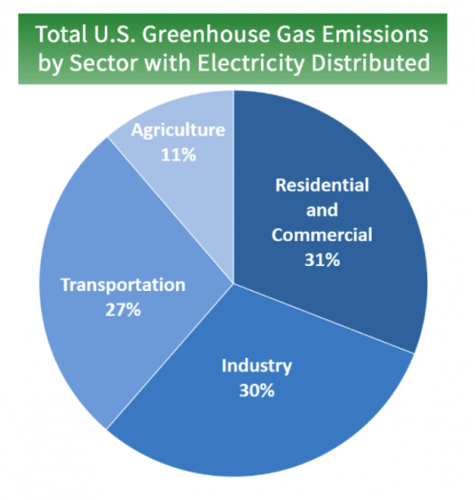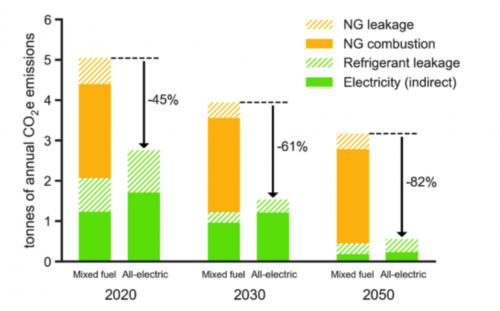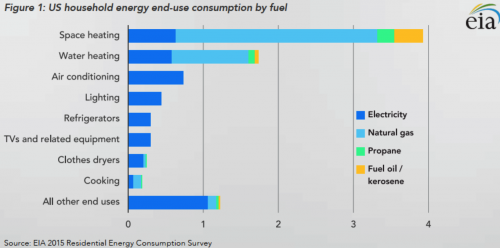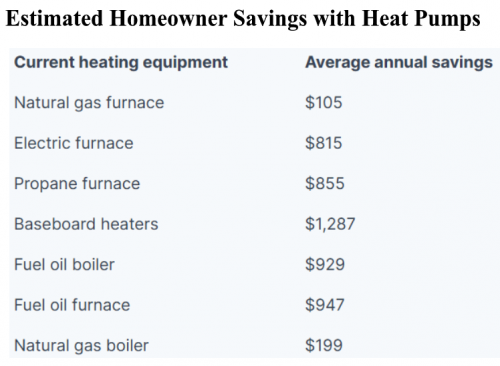Advanced Training on Building Electrification and Efficiency
What is “Building Electrification and Efficiency”?
Building electrification refers to the replacement of fossil-fueled technologies with electric ones in residential, commercial, and industrial buildings. These include electric heat pump space and water heaters and clothes dryers, and electric induction stoves.
Improving building efficiency means taking steps to reduce the amount of energy wasted to heat, cool, and light buildings. These measures include improving building insulation, installing thicker windows, sealing air leaks, and insulating water heaters and pipes. This training focuses mainly on residential electrification and efficiency.
Why Building electrification and efficiency are important
Upgrading our homes and other buildings can both reduce emissions and save people money. Buildings currently represent over 30% of US emissions. About 10% of building emissions come directly from onsite burning of fossil fuels and almost all the rest from generating the electricity buildings use. The biggest sources of direct emissions are space and water heaters, but stoves and clothes dryers are other examples in the residential sector.

Source: EPA
The best way to reduce those emissions is to switch to clean energy and to increase the efficiency with which we use all forms of energy to provide the services we want – heating, cooling, cooking, lighting, and more. Given that furnaces generally last 15–20 years and hot water heaters 8–12 years, it is essential that we start now accelerating the process of converting these appliances to clean energy.
Clean electricity complements building electrification
More than half of building emissions in the US come indirectly from the fossil-fueled electricity they consume. Accelerating the electricity sector’s shift to renewable and other low-carbon forms of generation will reduce these indirect emissions. Further electrifying buildings to eliminate fossil-fueled heating will add to this virtuous cycle. Emissions in the building sector will continue to fall as generation gets cleaner, even if buildings consume more electricity over time (see chart below).
As the electric grid decarbonizes, the emissions benefits of building electrification grow
(Projections by E3 of emissions from a Sacramento home built in the 1990s)

The National Renewable Energy Laboratory declared in a 2022 report on pathways to net-zero emissions by 2050 that “electrification of end uses in buildings (with a critical parallel focus on efficiency of those end uses) and much of transportation and industry is likely a key part of the most cost-effective pathway to achieving large-scale decarbonization across the economy.”
How much can building electrification and efficiency cut emissions?
Using efficient electric technology combined with clean power sources for heating, drying, and cooking would cut as much as 13% of US carbon emissions. Heating is by far the largest target because it consumes two-thirds of residential energy use, much of it provided by direct burning of fossil fuels:

Energy consumption in quadrillion btu. Sources: ICF and EIA.
Modern heat pumps can heat rooms and water much more efficiently than combustion heaters or traditional electrical resistance heaters. That’s because instead of directly heating air or water, they work by exchanging heat between indoors and outdoors, just as air conditioners do.
 Based on figures from the National Renewable Energy Laboratory and today’s current sources of electric generation, Carbon Switch calculated annual reductions in direct and indirect household CO2 emissions from switching to a heat pump, shown here in tons of CO2 saved per year. (These reductions will grow in time as electricity generation becomes cleaner.)
Based on figures from the National Renewable Energy Laboratory and today’s current sources of electric generation, Carbon Switch calculated annual reductions in direct and indirect household CO2 emissions from switching to a heat pump, shown here in tons of CO2 saved per year. (These reductions will grow in time as electricity generation becomes cleaner.)
As the organization points out, “That’s more than 10x more carbon savings than you’ll see installing LED lighting in your home.”
Taking steps to weatherize homes such as improving insulation and windows and sealing air leaks can further reduce emissions. Based Energy Innovation’s US Energy Policy Simulator, even with a rapid rate of electrification total US emissions can be reduced an additional 5% through increasing building energy efficiency.
Electrification and efficiency can save building owners and occupants money
Efficient heat pumps often save on energy costs as well as carbon emissions. Because heat pumps can double as air conditioners, they also eliminate the need for separate heating and cooling systems.

All-electric new construction usually lowers customer energy costs over time. In many parts of the country, dwellers can also enjoy lower monthly energy bills with electric retrofits (see chart at left from Carbon Switch).
Rewiring America estimates that electrifying space and water heating would lower average household bills $516 per year. A study released by the American Council for an Energy-Efficient Economy (ACEE) confirms that “electric heat pumps generally offer the cheapest way to cleanly heat and cool single-family homes in all but the coldest parts of the United States in coming decades.”
Substantial rebates and tax credits available through the federal Inflation Reduction Act, and many state and local programs make it much more economic for households – especially those with lower incomes – to purchase heat pumps, electric stoves and dryers, and upgraded electric panels. Rewiring America’s calculator can help you find these savings.
Remember, too, that improving building energy efficiency can increase cost savings and further reduce greenhouse gas emissions. The DOE estimates that its Weatherization Assistance Program saves families “an average of $437 annually in heating and cooling costs, with additional energy and cost savings from lighting and appliance upgrades.”
Are there other social benefits to building electrification and efficiency?
Yes! The most significant co-benefits are to peoples’ health. A 2020 report by Rocky Mountain Institute (RMI) cited research from MIT showing that “combustion emissions from the building sector now contributes to the largest share (37 percent) of premature deaths associated with air pollution, compared to other sectors like transport, industry, and power generation.” Unvented gas stoves are one culprit, producing indoor nitrogen oxides, carbon monoxide, and benzene pollution that can harm human health, including a 24–42% increased risk of childhood asthma. Gas heating also contributes to local air basin pollution.
Other benefits cited by proponents of electrification include reduced fuel price risks, lower dependence on petroleum imports, and workforce and economic development opportunities. Electrification can also bring opportunities as well as challenges to the power industry (see “Other Questions” below).
What types of policies can support building electrification and efficiency?
Traditional policies to promote building electrification and efficiency include:
- government subsidies to consumers for the purchase of efficient electric heating, cooling, and cooking appliances, and for building weatherization measures;
- subsidies to manufacturers of electric appliances;
- state and federal appliance performance standards;
- state and local building codes to encourage or require electrification in new construction and building retrofits;
- research and development to promote more efficient and less costly electric technology;
- consumer education campaigns; and
- dedicated workforce training programs.
The Inflation Reduction Act of 2022 is chock full of such incentives for both residential and commercial building owners and occupants. However, the Rhodium Group commented that the act’s impact on buildings will be “small compared to the scale of decarbonization needed” in that sector to meet US commitments under the Paris Agreement. “More action, actually focused on decarbonization and not just energy efficiency, is necessary in the buildings sector.”
How would a carbon price affect building electrification and efficiency?
One of the most effective policies to increase building electrification and efficiency would simply be to price carbon. By raising the cost of fossil fuels relative to carbon-free electricity, a carbon fee would motivate building owners and renters to switch from combustion to electric technology for space and water heating and cooking.
A carbon price would also accelerate the decarbonization of the electric power sector. A 2022 report on building electrification by the American Council for an Energy Efficient Economy (ACEEE) declared that a tax or fee on carbon emissions “would help equalize the market environment between electric end uses and fossil fuels and could be the single most impactful policy to drive building electrification forward on the federal and state levels.”
A carbon tax starting at just $15 per ton but rising $15 a year would slash direct and indirect building emissions by more than half over a decade, according to detailed projections by Columbia University economists working with Rhodium Group. (These estimates preceded the Inflation Reduction Act, and thus are best considered illustrative.) Reduced indirect emissions from the electric power sector account for most of that drop, but the tax would also cut direct emissions from natural gas by 12 percent.

Source: “Expanding the Reach of a Carbon Tax,” Columbia University, 2020
The model forecast that a rising carbon fee would cut building emissions by more than 1,000 million metric tons annually by 2030. The Columbia analysis determined that a moderately aggressive but realistic path of efficiency improvements could further reduce building emissions by 81 million metric tons annually over a decade. That’s a cut of about 11% in building emissions that would remain after a rising carbon fee.
What are some of the obstacles to electrification and efficiency?
- Given high labor and equipment costs, retrofitting millions of existing homes and commercial buildings will be extremely expensive and time consuming.
- Customer resistance may also prove strong in some parts of the country where electric rates are particularly high.
- Educating home and business owners about the benefits of efficient heat pumps will take time given the myriad issues competing for their attention.
- Finally, as with the electrification of transportation, electric utilities will have to cope with rapidly growing loads and changing daily and seasonal peaks as buildings shift from natural gas to electricity as their energy source.
How does building electrification address environmental justice issues?
Lower-income households already suffer disproportionately from exposure to air pollutants outside their homes. Within their homes, many have smaller kitchens and poor-quality ventilation, increasing their risk from gas cooking. They stand to benefit most from reducing levels of nitrogen oxide, carbon monoxide, formaldehyde, and other pollutants created by burning of fossil fuels in the home. They would also benefit economically from more efficient electrical appliances if assisted with purchase and installation costs.
The Greenlining Institute declares that “electrification can be a transformative force for low-income residents” under the right conditions, by providing “low-income communities access to major benefits such as cleaner air, healthier homes, good jobs and empowered workers, and greater access to affordable clean energy and energy efficiency to reduce monthly energy bills.”
Given the high up-front cost of buying a new home or replacing existing gas appliances, however, any equitable national strategy for building electrification must include substantial subsidies for heat pumps and other efficient appliances and electrical upgrades as well as technical assistance. The Inflation Reduction Act offers subsidies of up to $14,000 for low-income families for these upgrades, as well as funding for states to cover up to $4,000 per households in energy-saving measures like home weatherization. Taken as a whole, the act “provides $60 billion in grants, tax credits and other subsidies to meet the Administration’s Environmental Justice goals by helping lower income families transition to a clean energy economy and adapt to rising temperatures by increasing the energy efficiency of their homes, cars, and communities,” according to the National Energy Assistance Directors’ Association.
Ensuring an equitable transition is a key focus of many electrification proponents, including the Building Electrification Institute, as well as some utilities. This issue will need to be front and center of the national discussion to help millions of lower-income households make the transition successfully.
Can “renewable” gas replace “natural” gas as a clean heating fuel?
According to RMI, “‘Renewable’ natural gas (RNG) usually refers to biomethane that is created from sources such as wastewater, landfill methane, or agricultural waste and then pumped into the existing natural gas grid. RNG is expensive to develop, and at best it can only meet a small fraction of gas demand. Research overwhelmingly shows that RNG is likely to remain too limited and costly to decarbonize the buildings sector. It could only replace 3 to 12 percent of the existing demand for gas and is 4 to 17 times more expensive than fossil gas. Furthermore, because RNG supplies are limited, the best use of RNG will likely be in hard-to-decarbonize sectors such as industrial processes that cannot be easily electrified. Other alternatives, like hydrogen or synthetic methane, have also been touted by the gas industry as alternatives for decarbonizing buildings. These technologies face steep cost and infrastructure challenges to scale up, and they would ultimately require more electricity generation to produce than would be needed for an all-electric buildings sector.”
Can the electric power industry handle the greater loads from building electrification?
As with the electrification of vehicles, serving growing demand from the building sector will pose challenges to electric utilities. But with challenges come opportunities as well. Electrification offers many ways to promote more efficient and flexible operation of electric power generation, transmission, and distribution, according to a report by Lawrence Berkeley National Laboratory. By increasing total loads, it can make more intensive use of the grid, spreading fixed costs over more units of energy. A shift to electric heating with efficient heat pumps can better balance summer air conditioning loads with winter heating demand if managed properly. “Smart” controls on heat pumps for heating and cooling can help utilities manage variable loads and better integrate variable wind and solar resources into their systems. (For example, with customer permission, utilities could preheat water on summer mornings before facing peak afternoon air conditioning loads.)
Are heat pumps suitable substitutes for combustion heating in cold climates?
Yes. The latest models provide excellent service even in sub-zero temperatures. In very cold climates, they may require electrical resistance heating as a backup or other features that will add up-front cost but will pay back that cost over time through lower electric bills. Favorable test results in Maine support that state’s goal of installing 100,000 heat pumps by 2025. Cold Nordic nations have also successfully deployed the largest proportion of heat pumps among all countries.
What about commercial building electrification?
Both residential and commercial buildings are important for electrification and efficiency. We've focused our initial trainings on residential because we feel that is most accessible to our volunteers and most relevant for their grassroots outreach. Homes are something everyone can relate to.
In addition, residential buildings to contribute about 20% more CO2 emissions than commercial buildings, according to data from the U.S. Energy Information Administration, and they have more room for electrification. As of 2021, 44% of residential energy use was in the form of electricity, compared to 50% for commercial buildings.
There are plenty of opportunities for cost-effective electrification and energy-efficient upgrades of commercial buildings. Useful resources include the Department of Energy’s website “About the Commercial Buildings Integration Program” and a 2020 report by the American Council on an Energy-Efficient Economy on “Electrifying Space Heating in Existing Commercial Buildings: Opportunities and Challenges.”
Additional Resources
To explore additional websites and information on this essential topic, click here for the Resources tab.
- (0:00) Intro & Agenda
- (3:44) What does “Building Electrification and Efficiency” (BE&E) mean?
- (5:22) Why is it important for climate policy?
- (13:15) How can it save building owners money?
- (20:02) What policies support BE&E?
- (25:11) How will CCL engage?
- Jonathan Marshall
Acadia Center – offers a wealth of information on building electrification with a focus on the Northeast.
American Council for an Energy Efficient Economy – the premier champion of energy efficiency, this organization has published many reports on the building sector. See its policy brief on Home Energy Upgrade Incentives in recent federal laws, its candid discussion of Barriers and Strategies for Residential Electrification, and its excellent overview, Building Electrification: Programs and Best Practices (2022).
Building Decarbonization Coalition – This organization brings together building industry stakeholders with energy providers, environmental organizations and local governments to promote clean electrification. End users seeking information should go to its various state arms, such as The Switch is On, which targets Californians with practical tips on rebates and incentives, how to find a contractor, and explainers about heating and cooling, water heating, dryers, cooking, solar, batteries, and more.
Department of Energy, “A National Roadmap for Grid-Interactive Efficient Buildings” (2021) documents the enormous cost savings and emissions reductions made possible by smart electrification and efficiency investments in residential and commercial buildings.
Electrify Now – a website dedicated to giving guidance on how to clean up your electricity supply and electrify your home and transportation. Full of information, advice, and links to more.
Regeneration.org – Its superb page devoted to “Electrify Everything” is the place to go for further information on just about everything. Once you take the plunge into its pages you may never come out.
Rewiring America dubs itself “the leading electrification nonprofit, focused on electrifying everything in our communities.” Its website contains savings calculators, copious information on electrification incentives, and deeper-dive research. Check out its Home guide to electrification.
Rocky Mountain Institute – This renowned think-tank is a center of research and innovation on all things related to clean energy and efficiency.
Further information on heat pumps and home electric appliances:
- Department of Energy, “Purchasing Energy-Efficient Residential Air-Source Heat Pumps.”
- Department of Energy, Energy Star website on residential tax credits for heat pumps
- Georgia Power video, “How A Heat Pump Water Heater Works And Helps Save Energy”
- Greenfoot Energy Solutions, Heat-Pump Glossary
- Yale Appliance, Induction Cooking Buying Guide (2022)